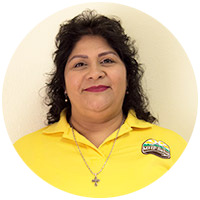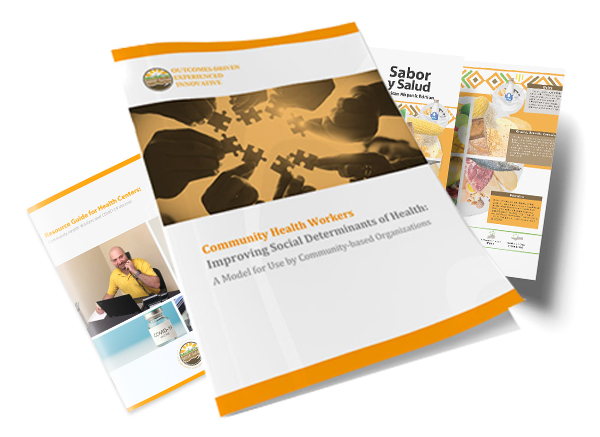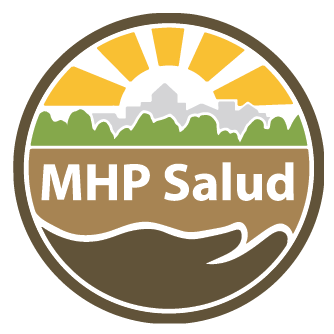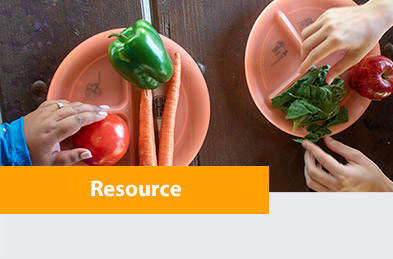Familismo and Fatalismo: Impact on Diabetes Management
Published October 2022 | Back to all news and updates.
- Why are Migrant Seasonal Agricultural Workers (MSAWs) at a high risk of having diabetes?
- What are Familismo and Fatalismo, and how do they relate to MSAWs and their diabetes management?
- How can Community Health Workers offer support to participants with diabetes or at risk of developing diabetes?
Diabetes prevalence among Migrant and Seasonal Agriculture Worker Communities
Diabetes is a chronic disease that affects many Americans. Hispanics are one of the most significant minorities in the United States and have higher rates of diabetes in adults and children when compared to other ethnic groups.1 According to the National Agricultural Workers Survey, 80 percent of the U.S., 2.4 million Migrant Seasonal Agricultural Workers (MSAWs) are Latino. 2 U.S. adults have a 40 percent chance of developing type 2 diabetes, compared to 50 percent chance for Hispanic/Latino adults. More than half of Hispanic/Latino adults are more likely to have prediabetes and expected to develop type 2 diabetes in their lifetime.1
Health and Risk Factors
MSAWs are predominantly Latino, which places them at higher risk of having diabetes. Many health and risk factors contribute to MSAWs diabetes rates, including dietary choices, weight management, sociocultural, genetic, and cultural factors.3 MSAWs work long hours and are exposed to harsh chemicals such as pesticides which has been associated with type 2 diabetes.4 They travel for work and often temporarily reside in rural, low-economic areas limiting their access to local resources such as nutritious food and medical care. MSAW rates of obesity are higher than other ethnic groups, which may be associated with dietary choices, including high intake of sugar and simple carbohydrates. Simple carbohydrates (i.e., pastries, soft drinks and white rice) can spike blood sugar levels and are common food choices among MSAWs.5 Rates of obesity among Latino/MSAW families can be influenced by culture and parenting styles. In the Latino culture, visitors are greeted with food and celebrations are centered around food which often may include sugary drinks and high carb meals.
How Culture, Familismo and Fatalismo Impacts Diabetes Control and Management
Psychology Today defines familismo as “a central Latinx cultural value involving dedication, commitment, and loyalty to family.” Familismo means spending time with family, seeking their support or approval on important decisions, and placing the value of family above all.6
Familismo is critical to understand as it relates to MSAWs and their diabetes management. In Latino culture, Familismo means putting others’ needs before themselves in all aspects. For example, MSAWs may not want to miss a day of work to seek medical care or spend money on expensive medicines or treatment for themselves if it will cause them to miss out on their daily earnings to provide for their families.
Holistic medicine is an attitudinal approach to health care rather than a particular set of techniques,3 and is a health practice used in Latino culture. It is widespread for MSAWs traveling from border towns to take medicine with them as they travel north for work and self-medicate themselves based on what others are taking for similar conditions.
Fatalismo refers to a general belief that the course of fate cannot be changed and that life events are beyond one’s control.7 In other words, fatalismo means that if it is fate, then it cannot be changed. In the Latino culture, this can be specifically true as it relates to diabetes management, genetics, and culture. Some reason that “if my parents have diabetes and their parents had diabetes, then I will have diabetes regardless of preventive measures such as diet and exercise.”
Social stigma affects MSAWs in their diabetes management. Diabetes stigma occurs when a person with diabetes feels excluded, ashamed, rejected, or blamed for their chronic condition. Much of the stigma with diabetes and MSAWs can be related to having certain restrictions at work. Certain observable behaviors and characteristics of diabetes may lead a person to feel stigma and shame.
Examples include:
- Taking insulin injections
- Having hypoglycemic episodes
- Regularly monitoring blood glucose levels
- Adhering to dietary restrictions
- Having excess body weight 8
CHW interventions addressing diabetes management and prevention.
Community Health Workers (CHWs) are trusted members of the community they serve. They work in clinical and non-clinical settings providing health education and referrals to the community for local organizations that assist with health and social services. CHWs meet participants where they are – at home, at work, or out in the community – to better reach participants and meet their unique needs. While their primary role is often linking vulnerable populations to the health system, additional roles can include cultural mediation, culturally appropriate education, care coordination, case management, systems navigation, coaching and social support, advocacy, capacity building, and outreach. Through these roles, CHWs offer support to participants with diabetes or at risk of developing diabetes in a culturally appropriate manner. CHWs also conduct home visits and speak one-on-one with participants on the importance of proper nutrition, physical exercise, and disease management.9
CHW-led programs provide accessible support and education to vulnerable populations to live healthier lives. CHWs can help a participant better understand their diagnosis, the symptoms, and complications of their disease in their language and level of understanding. CHWs visit participants in their homes and meet with their support systems to encourage the family to make lifestyle changes together. These lifestyle changes include incorporating physical activity, taking medications as prescribed and helping participants set realistic goals for better health.
Many CHWs are bilingual, which helps to better connect and communicate with their communities. CHWs link participants with resources in their language, such as Spanish-speaking medical facilities and written resources in their preferred language. CHWs, if permitted, can translate and assist participants in applying for community services. Since CHWs speak the same language and are from the community they serve, they can better understand participants’ needs, culture, and beliefs. This is important because it is common in the Latino/Hispanic culture to self-medicate, share medication, and practice holistic medicine, including home remedies. A CHW can relate to and acknowledge the participants’ beliefs on health while providing health education and referrals on modern medicine.
Community Health Workers help participants understand misinformation they have heard from other community members or other sources. Due to their intimate understanding of and trust from the community they serve, CHWs have a unique ability to build strong relationships and effectively address challenges individuals face when trying to manage chronic conditions. Overall, CHW interventions have successfully improved health outcomes among individuals diagnosed with diabetes.9
CHWs are the link to resources within the community (i.e., application assistance, locating food banks, vaccine locations, etc.) and we are sometimes the only support our participants have. My role as a CHW goes beyond basic health education as I encourage participants to practice self-care, attend medical appointments, take medications as prescribed and the importance of taking pride in their overall health.
Mary Zepeda
MHP Salud Community Health Worker

Want to learn more about our diabetes prevention and management initiatives?
Click here!
Diabetes Resources
- The Farmworker Justice resource center shares videos for MSAWs in Mam and Mixteco about making healthy choices while living with Diabetes. The online resource center also shares interactive coloring activities and recipes for healthy eating. To access the resources, click here.
- The National Center for Farmworker Health, Inc. (NCFH) will be hosting webinars related to organizations that serve MSAW and other special populations with the goal of increasing knowledge, skills and abilities. To view the upcoming webinars, click here.
- The Association of Diabetes care and Education Specialist website shares online Tools and Resources to help manage diabetes, prediabetes, or other chronic conditions to include monitoring, reducing risks and healthy eating to name a few. To access this resource, click here.
- The American Diabetes Association (ADA) shares online diabetes resources to include a risk test and health education topics to understand Diabetes diagnosis, A1C and Diabetes symptoms and complications. To access the ADA Resources, click here.
- The Centers for Disease Control (CDC) shares online resources on Diabetes Education and Support. These resources include Diabetes Basics, healthy eating, being active, diet and exercise and Diabetes care during emergencies. To access this resource, click here.
- https://www.cdc.gov/diabetes/library/features/hispanic-diabetes.html
- https://www.farmworkerjustice.org/wp-content/uploads/2018/08/ISSUE-BRIEF-FORMATED.pdf
- https://www.ncbi.nlm.nih.gov/pmc/articles/PMC6953173/
- http://www.ncfh.org/diabetes-fact-sheet.html#:~:text=Agricultural%20workers%20may%20be%20particularly,of%20poverty%20to%20migratory%20status.&text=Self%2D
management%20for%20diabetes%20includes,and%20access%20to%20prescription%20drugs. - https://baptisthealth.net/baptist-health-news/diabetes-and-hispanics-understanding-risks-and-prevention/
- https://www.psychologytoday.com/us/blog/life-in-the-intersection/201704/familismo
- https://www.ncbi.nlm.nih.gov/pmc/articles/PMC3617551/
- https://www.medicalnewstoday.com/articles/type-2-diabetes-stigma#definition
- https://mhpsalud.org/our-chw-initiatives/community-health-workers/
HRSA Disclaimer
This publication is supported by the Health Resources and Services Administration (HRSA) of the U.S. Department of Health and Human Services (HHS) as part of an award totaling $678,959.00 with 0 percentage financed with nongovernmental sources. The contents are those of the author(s) and do not necessarily represent the official views of, nor an endorsement, by HRSA, HHS or the U.S. Government. For more information, please visit www.HRSA.gov.
Blog Topics
This resource provides educational tools that Community Health Workers (CHWs) can use and share with Migrant Seasonal Agricultural Workers and other vulnerable populations to reduce diabetic health complications in oral, eye, and foot health, which are commonly linked to diabetes.








